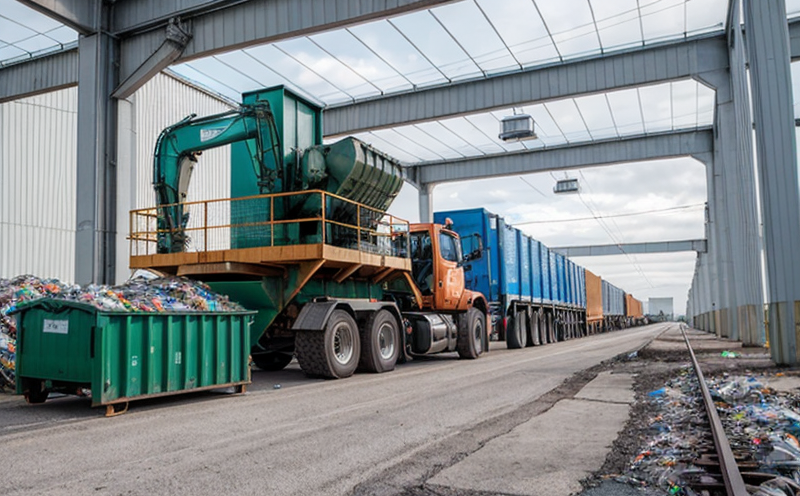EN 13431 Packaging Energy Recovery Testing Validation Method Development Test
The European Standard EN 13431-1:2006 provides a comprehensive framework for the testing and validation of packaging materials intended for energy recovery. This method is critical in ensuring that packaging materials meet regulatory requirements for recycling and energy recovery, thereby supporting sustainability goals within industrial manufacturing processes.
Energy recovery involves the conversion of waste products into useful forms such as heat or electricity. Packaging plays a vital role in this process by being able to withstand the rigorous conditions required for efficient combustion. The EN 13431-1 test assesses various properties of packaging materials, including their resistance to mechanical stress, thermal stability, and ash content, which are essential factors in determining suitability for energy recovery.
The testing protocol outlined in this standard involves several stages: sample preparation, conditioning, calorimetry, and ash determination. Samples must first be prepared according to specified procedures to ensure consistency across tests. Conditioning ensures that samples reach an appropriate temperature before analysis. Calorimetry measures the heat produced when materials are combusted, while ash content indicates the proportion of non-combustible material present. Each stage is crucial in validating whether a packaging material can effectively contribute to energy recovery processes.
For accurate results, laboratories must adhere strictly to ISO and EN standards during testing. This ensures reliability and consistency across different facilities and regions. The use of advanced instrumentation like differential scanning calorimeters (DSC) and proximate analysis equipment enhances precision and accuracy in measuring key parameters. Reporting should include detailed descriptions of methods used, observed data points, calculated values, and conclusions drawn based on these findings.
Understanding the implications of this test is crucial for quality managers, compliance officers, R&D engineers, and procurement teams involved in industrial recycling initiatives. By validating packaging materials through EN 13431-1 testing, organizations can ensure they are meeting both regulatory obligations and sustainability goals. This not only enhances operational efficiency but also promotes responsible resource management.
Implementing this test early in product development cycles allows for iterative improvements based on feedback from preliminary assessments. Early identification of potential issues saves time and costs associated with rework or scrap later down the line. Additionally, it fosters innovation by encouraging exploration into new materials that could better suit energy recovery processes without compromising functionality.
Compliance officers should familiarize themselves with this standard as part of their broader responsibilities related to environmental policies and initiatives. Adhering to these guidelines demonstrates commitment to sustainable practices while also protecting against penalties for non-compliance. R&D engineers can leverage the insights gained from EN 13431-1 testing to refine existing products or develop entirely new solutions tailored specifically towards achieving desired outcomes within energy recovery frameworks.
For procurement teams, understanding this test helps in selecting suppliers who prioritize sustainability and adherence to relevant standards. Ensuring consistent quality among various supply chains is essential for maintaining high levels of performance across all operations. By partnering with reliable vendors capable of delivering compliant materials consistently, businesses can minimize disruptions caused by subpar products or frequent changes in supplier offerings.
Why It Matters
The importance of validating packaging energy recovery cannot be overstated given the growing emphasis on reducing waste and promoting circular economy principles. By ensuring that packaging materials are suitable for energy recovery, industries contribute significantly towards achieving global sustainability targets set forth by organizations like the United Nations Environment Programme (UNEP) and the European Union’s Circular Economy Action Plan.
Implementing EN 13431-1 testing demonstrates a proactive approach to waste management, reducing landfill volumes while simultaneously creating value from what would otherwise be considered waste. This aligns perfectly with corporate social responsibility goals and helps build positive brand reputation among environmentally conscious consumers. Moreover, compliance with international standards enhances trust between stakeholders involved in supply chains, fostering long-term partnerships based on shared values.
From an economic perspective, embracing this practice leads to cost savings by optimizing resource utilization throughout the lifecycle of packaging products. Efficiently managing waste streams through recycling and energy recovery reduces disposal costs significantly, translating into increased profitability for businesses engaged in these activities. Furthermore, it opens up opportunities for collaboration with other actors within the circular economy network such as material suppliers, recyclers, and end-users.
In conclusion, adopting EN 13431-1 testing is not just a requirement but also an opportunity to drive innovation, enhance operational efficiency, and contribute meaningfully towards sustainable development. It plays a pivotal role in shaping the future of industrial manufacturing processes by embedding circular economy principles into core business practices.
Benefits
- Enhanced Compliance: Ensures strict adherence to relevant regulations and industry best practices.
- Improved Efficiency: Identifies potential issues early in the product development cycle, minimizing rework and scrap.
- Innovation Opportunities: Encourages exploration into new materials that better suit energy recovery processes.
- Better Brand Reputation: Demonstrates commitment to sustainable practices among environmentally conscious consumers.
- Economic Savings: Optimizes resource utilization, reducing disposal costs and enhancing profitability.
- Long-Term Partnerships: Fosters trust within supply chains by aligning with shared values around sustainability.
Industry Applications
| Application Area | Description of Application |
|---|---|
| Packaging Manufacturers | Evaluating the suitability of different packaging materials for energy recovery. |
| Recycling Facilities | Determining the optimal conditions required for effective combustion and maximum calorific value extraction. |
| Circular Economy Initiatives | Supporting projects aimed at minimizing waste through efficient recycling and conversion into useful forms. |
| Sustainability Consultancies | Providing expert advice on how to incorporate EN 13431-1 testing into broader sustainability strategies. |





